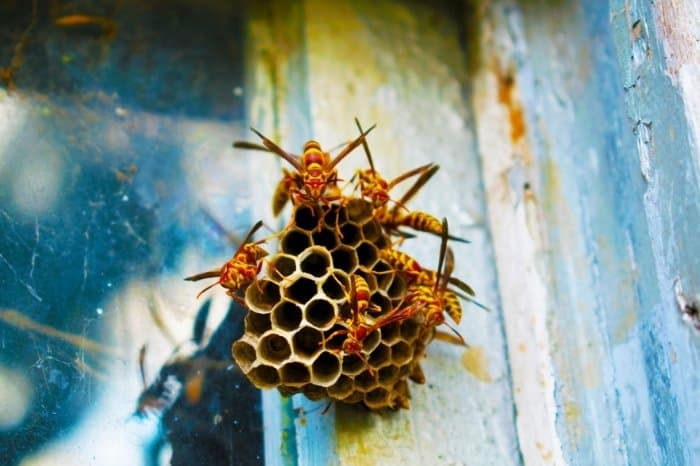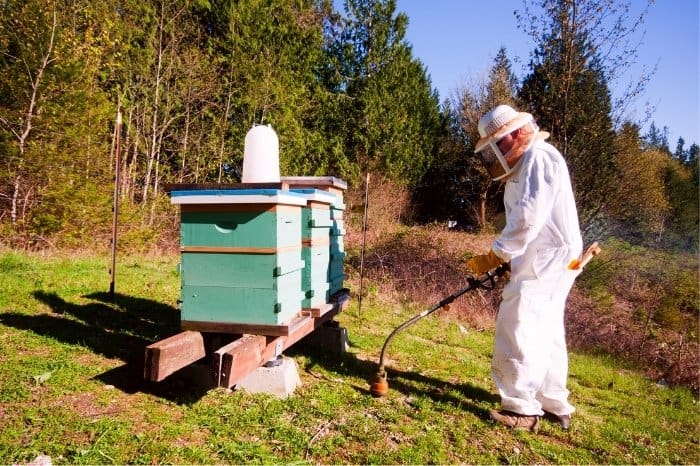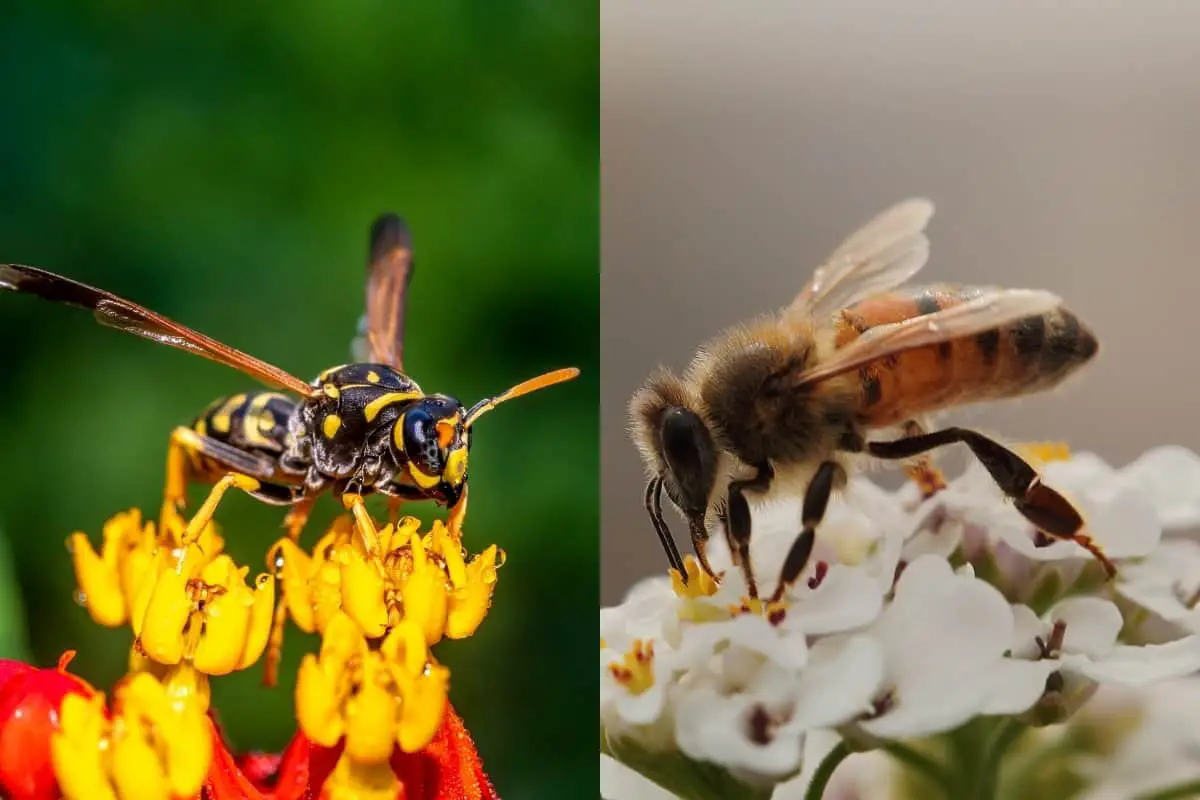Last Updated on January 8, 2023 by Urska
Yellow jackets and honeybees are not friends because one is an enemy of the other, do yellow jackets kill honeybees, or do we just misinterpret them?
For new beekeepers, it is challenging and heartbreaking to have pests cause problems to your bees. One of the common pests is yellow jackets.
Yellow jackets are destructive pests that cause bee farmers lots of problems. If a beekeeper does not notice them early enough, they will destroy a thriving honeybee colony.
Bee farmers must know how to protect their bees from these invasive yellow jackets.
On the contrary, yellow jackets are also useful in farming so do not do away with them rather keep them from the hive.
So What Are These Yellow Jackets That Kill Honeybees?
Yellow jackets belong to the wasp and hornet family. They are invasive pests that attack honeybees.
These social insects mostly live in underground nests, on shrubs, in trees, and protected areas like the cavities. These insects are black and yellow in color. You can easily distinguish them by their thin waist.
These wasps are predatory and very aggressive. They fly in a characteristic side-to-side pattern before landing.
When food is in plenty, these wasps will not disturb the bees. However, if there is a shortage, they invade beehives in search of food. This commonly happens in autumn when the food supply goes low.
Yellowjackets adults feed on carbohydrates and sugar-laden foods while the young ones eat meat. The larvae of honeybees are a rich source of food for the yellow jacket family. These pests strike almost at the same time as robber bees attack, so beware.
These wasps can cause lots of damage within a short period. If a severe invasion happens, yellow jackets destroy your honeybee colony sending them all packing.
Beekeepers should protect honeybees from yellow jackets right from the beginning. Identify any yellow jackets and analyze if they are a problem and work on controlling their population around your beehive.
Check Out A Guide on How to Get Rid of Hoverflies
How Do Yellow Jackets Affect Honeybees?
The yellow jacket wasps are notorious for eating honey and destroying honeycomb. As if that is not enough, they kill adult bees, eat the honeybee’s eggs and eat up all their larvae.
Yellowjackets even kill the queen bee as if they are just killing another bee in the hive. An invasion of the yellow jacket in a beehive brings quick destruction to the honeybee colony. The result of a yellow jacket invasion in a beehive is the quick destruction of the honeybee colony.

Within a few hours, the entire bee colony is left without brood with all its honey reserves eaten up or destroyed.
An invasion causes the honeybees to abandon the beehive in search of a new place to rebuild the colony.Check out
Read more about:
What Attracts These Yellow Jackets To Kill Honeybees?
Lack of food is the major problem that causes these destructive pests to invade the beehives. The smell of honey attracts these insects from afar due to the pheromones produced by bees. This chemical gives away the location of a beehive to these pests. They can smell it from afar.
To try to keep these pests away, clear all the dead bees so they are not noticed by the yellow jacket near the beehive. When noticed, the yellow jackets will attack the beehive without mercy and terribly destroy your honeybees.
Your honeybees feeding stations outside the hive could also attract yellow jackets and direct them to a nearby beehive.
During autumn, place the feeding stations inside the beehive instead of outside to tame these pests.
Natural Cotton Medium / Large Professional Beekeeping Beekeepers Hat Veil
Keeping Yellow Jackets From Your Beehives
Beekeepers have several measures they put in place to prevent yellow jackets from accessing the hive. They include
1. Have Fewer Entrances. Keep your beehive entrances few and properly covered to keep these wasps away. Fewer entrances are easy for bees to guard and provide increased effectiveness for honeybees guarding the entrances to the beehive. They are also able to protect the young ones and newly installed honeybee colonies.
2. Use Baits And Traps. Baiting is another effective way to prevent yellow jackets from accessing the beehive. Use traps that are baited to kill yellow jackets or hold them captive. It’s not advisable to kill them, however, if you notice their population is too high around your hives you can move them away or kill them. If you freeze them overnight, you will kill them. Set your traps around your beehive or near a yellow jacket nest. Once caught, you can empty the trap and set it again.
3. Use Soapy Water. The soapy water solution traps the insects leading to their death from exhaustion. This trap kills these wasps and a good number accumulates at the top of the solution. The floating mass of dead wasps may provide a warning to the other yellow jackets. It is important to check your soapy solution time-to-time and empty the dead wasps. As you inspect, you can add a bait or replace it if fermented. The soapy water is homemade and should be wide at the top to prevent amassing of dead yellow jackets. The traps are highly effective in catching hundreds of these wasps within a short time. Use meat in your traps as an attraction. Chicken meat is the best meat to use as it attracts these wasps from afar. It draws these wasps into the trap and they fall into the soapy water solution yellow jackets into the trap as they try to bite the meat. They eventually drown in the water.

FAQs
Can honey bees and yellow jackets live together?
Honey bees are the most efficient pollinators on the planet, but they are also the targets of some of the most vicious species in nature. Yellow jackets have a reputation for being fearless. They’re also known for stinging humans, so it’s no wonder that honey bees are sometimes terrified of them.Honey bees can indeed coexist with yellow jackets in some instances. But the honey bee’s survival depends on a few factors. These include the type of yellow jacket species, how close together they are, how many bees there are, and whether the yellow jackets have recently been disturbed by a human or other source.
“Yellow jacket colonies do get established in some areas, but it’s not common,” said Paul Morse, an entomologist at the University of Maryland, who specializes in honey bee research. “It’s a lot more common to find honey bees in yellow jackets than the other way around.” Yellow jackets also seem to prefer warmer, drier environments than honey bees.
The research team found that a yellow jacket colony could thrive for only about eight months in the wild, although in the lab it could last up to six months. It’s unclear what factors are limiting the longevity of wild colonies. The study found that the temperature inside a colony could vary between 27 and 40 degrees Celsius, but even then the average temperature stayed just above 30 degrees Celsius.
Do Yellow Jackets fight bees?
According to the University of Georgia's College of Agricultural and Environmental Sciences, the answer is no. The university's website says, "Yellow jackets are social insects and do not fight other yellow jackets." Keep Learning According to the UGA website, a yellow jacket will typically chase away a bee by stinging it.
A yellow jacket will usually try to get away from a bee by running in a zigzag pattern. However, it will sting the bee when it gets too close.
How do you keep yellow jackets away?
The best way to keep yellow jackets away is to get rid of their source of food and water. Yellow jackets are omnivores, meaning they will eat both plant and animal matter. Yellow jackets prefer to build nests in the ground or under objects that provide shelter and protection from the elements, such as rocks and logs. Nests can be found on sidewalks, buildings, trees, and even inside crawlspaces.
Once a nest is located, it should be sealed off with sealant and sealed shut with duct tape or caulk. If you have any concerns about the health of the yellow jackets or their eggs, contact your local pest control professional for more information. While yellow jackets are not harmful to humans, they can be aggressive and bite when provoked. If you’re allergic to bee stings, wear protective clothing and equipment.
Are yellow jacket trap safe for honey bees?
Yellow jacket traps are not safe for honey bees. They are also illegal to use in some states, including California and New York. The problem is that they attract the queen bee as well as worker bees. If you put a yellow jacket trap near a hive, the bees will go inside, find the queen, and she will be killed.
Conclusion
FAQs
Can honey bees and yellow jackets live together?
Honey bees are the most efficient pollinators on the planet, but they are also the targets of some of the most vicious species in nature. Yellow jackets have a reputation for being fearless. They’re also known for stinging humans, so it’s no wonder that honey bees are sometimes terrified of them.Honey bees can indeed coexist with yellow jackets in some instances. But the honey bee’s survival depends on a few factors. These include the type of yellow jacket species, how close together they are, how many bees there are, and whether the yellow jackets have recently been disturbed by a human or other source.
“Yellow jacket colonies do get established in some areas, but it’s not common,” said Paul Morse, an entomologist at the University of Maryland, who specializes in honey bee research. “It’s a lot more common to find honey bees in yellow jackets than the other way around.” Yellow jackets also seem to prefer warmer, drier environments than honey bees.
The research team found that a yellow jacket colony could thrive for only about eight months in the wild, although in the lab it could last up to six months. It’s unclear what factors are limiting the longevity of wild colonies. The study found that the temperature inside a colony could vary between 27 and 40 degrees Celsius, but even then the average temperature stayed just above 30 degrees Celsius.
Do Yellow Jackets fight bees?
According to the University of Georgia's College of Agricultural and Environmental Sciences, the answer is no. The university's website says, "Yellow jackets are social insects and do not fight other yellow jackets." Keep Learning According to the UGA website, a yellow jacket will typically chase away a bee by stinging it.
A yellow jacket will usually try to get away from a bee by running in a zigzag pattern. However, it will sting the bee when it gets too close.
How do you keep yellow jackets away?
The best way to keep yellow jackets away is to get rid of their source of food and water. Yellow jackets are omnivores, meaning they will eat both plant and animal matter. Yellow jackets prefer to build nests in the ground or under objects that provide shelter and protection from the elements, such as rocks and logs. Nests can be found on sidewalks, buildings, trees, and even inside crawlspaces.
Once a nest is located, it should be sealed off with sealant and sealed shut with duct tape or caulk. If you have any concerns about the health of the yellow jackets or their eggs, contact your local pest control professional for more information. While yellow jackets are not harmful to humans, they can be aggressive and bite when provoked. If you’re allergic to bee stings, wear protective clothing and equipment.
Are yellow jacket trap safe for honey bees?
Yellow jacket traps are not safe for honey bees. They are also illegal to use in some states, including California and New York. The problem is that they attract the queen bee as well as worker bees. If you put a yellow jacket trap near a hive, the bees will go inside, find the queen, and she will be killed.
Every farmer’s dream is to keep honeybees because they are becoming rare in America and they are highly beneficial to your garden. Not forgetting the abundant healthy honey they give us.
You don’t want anything destroying all your efforts to keep your honeybees no matter what. That’s why you will always stay vigilant to watch out for the yellow jackets wasps that could finish your hive in a day.
When you notice even one wasp, be sure to use traps to eliminate them before they invade your hives.
All the best in your bee farming!
FAQs
Can honey bees and yellow jackets live together?
Honey bees are the most efficient pollinators on the planet, but they are also the targets of some of the most vicious species in nature. Yellow jackets have a reputation for being fearless. They’re also known for stinging humans, so it’s no wonder that honey bees are sometimes terrified of them.Honey bees can indeed coexist with yellow jackets in some instances. But the honey bee’s survival depends on a few factors. These include the type of yellow jacket species, how close together they are, how many bees there are, and whether the yellow jackets have recently been disturbed by a human or other source.
“Yellow jacket colonies do get established in some areas, but it’s not common,” said Paul Morse, an entomologist at the University of Maryland, who specializes in honey bee research. “It’s a lot more common to find honey bees in yellow jackets than the other way around.” Yellow jackets also seem to prefer warmer, drier environments than honey bees.
The research team found that a yellow jacket colony could thrive for only about eight months in the wild, although in the lab it could last up to six months. It’s unclear what factors are limiting the longevity of wild colonies. The study found that the temperature inside a colony could vary between 27 and 40 degrees Celsius, but even then the average temperature stayed just above 30 degrees Celsius.
Do Yellow Jackets fight bees?
According to the University of Georgia's College of Agricultural and Environmental Sciences, the answer is no. The university's website says, "Yellow jackets are social insects and do not fight other yellow jackets." Keep Learning According to the UGA website, a yellow jacket will typically chase away a bee by stinging it.
A yellow jacket will usually try to get away from a bee by running in a zigzag pattern. However, it will sting the bee when it gets too close.
How do you keep yellow jackets away?
The best way to keep yellow jackets away is to get rid of their source of food and water. Yellow jackets are omnivores, meaning they will eat both plant and animal matter. Yellow jackets prefer to build nests in the ground or under objects that provide shelter and protection from the elements, such as rocks and logs. Nests can be found on sidewalks, buildings, trees, and even inside crawlspaces.
Once a nest is located, it should be sealed off with sealant and sealed shut with duct tape or caulk. If you have any concerns about the health of the yellow jackets or their eggs, contact your local pest control professional for more information. While yellow jackets are not harmful to humans, they can be aggressive and bite when provoked. If you’re allergic to bee stings, wear protective clothing and equipment.
Are yellow jacket trap safe for honey bees?
Yellow jacket traps are not safe for honey bees. They are also illegal to use in some states, including California and New York. The problem is that they attract the queen bee as well as worker bees. If you put a yellow jacket trap near a hive, the bees will go inside, find the queen, and she will be killed.
Caroline is a gardener who loves to get down to the nitty–gritty of gardening. She proudly proclaims herself as a ‘dirt worshipper‘ and can often be found deep in the garden, covered in soil and singing to her plants. As a self–proclaimed ‘plant whisperer‘, Caroline believes that plants need love and attention just like any other living thing, and she loves to give them both. When she‘s not tending to her garden, you can often find her researching the latest gardening trends, or teaching others how to make their gardens thrive



